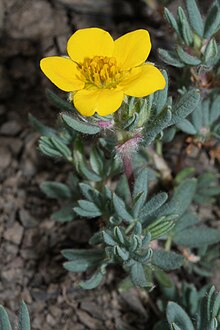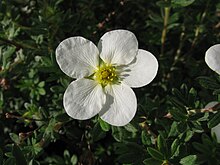Dasiphora fruticosa
| Dasiphora fruticosa | |
|---|---|

| |
| Dasiphora fruticosasubsp.floribunda | |
| Scientific classification | |
| Kingdom: | Plantae |
| Clade: | Tracheophytes |
| Clade: | Angiosperms |
| Clade: | Eudicots |
| Clade: | Rosids |
| Order: | Rosales |
| Family: | Rosaceae |
| Genus: | Dasiphora |
| Species: | D. fruticosa
|
| Binomial name | |
| Dasiphora fruticosa | |
| Synonyms[1] | |
|
List
| |

Dasiphora fruticosais aspeciesofhardydeciduousfloweringshrubin thefamilyRosaceae,nativeto the cooltemperateandsubarcticregions of the northern hemisphere, often growing at high altitudes in mountains.Dasiphora fruticosais still widely referenced in the horticultural literature under its synonymPotentilla fruticosa.Common names includeshrubby cinquefoil,[2]golden hardhack,[2]bush cinquefoil,[2]shrubby five-finger,[3]widdy,[2]kuril tea[4]andtundra rose.[5]
Description
[edit]It grows to 0.1–1 m (3.9–39.4 in) tall, rarely up to 1.5 m (4.9 ft). The habit is variably upright to sprawling orprostrate,but stems are often ascending especially those stems with many long branches. Thebarkof older stems is shreddy with long thin strips. The plants are densely leafy, theleavesdivided into five or seven (occasionally three or nine)pinnateleaflets. The leaflets are linear-oblong, 3–20 mm (0.1–0.8 in) long, with entire margins and more or less acute ends. The foliage (both leaves and young stems) is pubescent, variably covered in fine silky, silvery hairs about 1 mm long. Theflowersare produced terminally on the stems and are 2–3 cm (0.8–1.2 in) cm across,buttercup-shaped, with five petals and 15–25 stamens; the petals are pale to bright yellow (orange to reddish in some western Chinese populations). Thefruitis a cluster ofachenescovered with long hairs. The species is variablydioeciousorbisexual;flowering is typically from early to late summer. It is normally found growing in moisture-retentive soils in swamps and rocky areas.[6][7][8][9][10][11]
The plant is usually only eaten by wildlife when other food sources are scarce,[12]but the leaves of the plant may be boiled to make atisanecalled kuril tea.[4]
Taxonomy
[edit]Sources vary in the number of infraspecific taxa accepted. As of May 2022[update],theGermplasm Resources Information Network(GRIN) accepts twosubspecies:[2]
- Dasiphora fruticosasubsp.fruticosa.Described from Yorkshire, England and Öland, Sweden.[13]Northern Europe (scattered, in Estonia, Great Britain, Ireland, Latvia, and Sweden) and northern and central Asia.[14]
- Dasiphora fruticosasubsp.floribunda(Pursh) Kartesz(syns.Potentilla floribundaPursh.,Dasiphora floribunda(Pursh) Raf.,Pentaphylloides floribunda(Pursh) A.Love)). Described from Canada, New York, and New Jersey, North America.[15]Asia, southern Europe (Spain east to Bulgaria), and North America.[10][16][17][18]
As of May 2022[update],Plants of the World Onlinedoes not recognizeDasiphora fruticosasubsp.floribunda,but does recognize avarietydistinct fromDasiphora fruticosavar.fruticosa:[19]
- Dasiphora fruticosavar.veitchii(E.H.Wilson) Nakai(synsDasiphora veitchii(E.H.Wilson) Soják,Potentilla arbusculavar.veitchii(E.H.Wilson) Liou,Potentilla veitchiiE.H.Wilson), native to China (Sichuan, Yunnan)[20]
Numerous other varieties have been described from Asia, some of which have not yet been published under the genusDasiphora,and others in that genus only as distinct species. These includePotentilla fruticosavar.albicansRehd. & Wils.,P. f.var.arbuscula(D.Don) Maxim. (syn.Dasiphora arbuscula(D.Don) Soják),P. f.var.dahurica(Nestl.) Ser. (syn.Dasiphora dahurica(Nestl.) Komarov),P. f.var.pumilaJ.D.Hooker,P. f.var.mandschurica(Maxim.) Wolf (syn.Dasiphora mandshurica(Maxim.) Juz.), andP. f.var.unifoliolataLudlow (syn.Dasiphora unifoliolata(Ludlow) Soják). The varietiesD. f.var.monticolaRydb. andD. f.var.tenuilobaRydb. have been described from western North America, but are not widely accepted as distinct.[8][11]
Cultivation and decorative uses
[edit]
Shrubby cinquefoil is a popularornamental plantin temperate regions. Differentcultivarsare variable with flowers ranging from white to yellow, orange and pink, but they are allhardyplants that produce flowers for much of the summer. The flowers are always small, flat, and round, but there are many dozens on each bush. It is very often used by cities and businesses for landscaping because of its hardiness and low maintenance. It was introduced into cultivation in the 18th century, but many of the modern cultivars, particularly those with orange or red flowers, derive from collections byReginald Farrerin western China in the early 20th century.[11]The vast majority of sellers and gardeners still use the old namePotentilla fruticosa.
All the characteristics of small leaves, delicate flowers, and orange to brown flaky bark make the shrubby cinquefoil suitable forBonsai.It is very popular in Japan and is gaining popularity in Europe.[21]
Cultivars
[edit]Below is a recommended selection of over 130 cultivars which have been named. Those markedagmhave gained theRoyal Horticultural Society'sAward of Garden Merit.[11][22][23]
- 'Abbotswood' - large white flowers and bluish green foliage.agm[24]
- 'Beanii' - green foliage and white flowers.
- 'Chelsea Star' - small yellow flowers.agm[25]
- 'Coronation Triumph' - medium-bright yellow flowers, plants are drought- and cold-tolerant and heavy bloomers.
- 'Daydawn' - salmon-pink flowers.
- 'Day Dawn Viette' - peach-soft rose flowers highlighted with cream.
- 'Elizabeth' - yellow flowers to 3.5 cm diameter.
- 'Farreri' - leaves mostly with seven leaflets, flowers golden yellow.
- 'Farrer's White' - as 'Farreri', but with white flowers.

- 'Goldfinger' - deep golden-yellow flowers on plants with dark green foliage, good plant form and heavy flowering.
- 'Groneland' - white flowers tinged yellow.agm[26]
- 'Hopleys Orange' - orange flowersagm[27]
- 'Jackman's Variety' - yellow flowersagm[28]
- 'Katherine Dykes' - gracefully arching branches with lemon-yellow flowers, medium green foliage; needs regular trimming to keep from becoming leggy
- 'King Cup' - bright yellow flowers similar tokingcupagm[29]
- 'Klondike' - large bright yellow flowers, 3.5–4 cm diameter
- 'Limelight' - pale yellow flowers with darker centresagm[30]
- 'Marian Red Robin','Marrob' (PBR) - red flowers, yellow on reverseagm[31]
- 'Maanelys' ('Moonlight') - leaves blue-green, flowers pale yellow
- 'Mckay's White' - creamy white flowers
- 'Medicine Wheel Mountain' - almostprostratewith bright yellow flowersagm[32]
- 'Mount Everest' - flowers large, 3-3.5 cm, white
- 'Pink Beauty' - deep pink flowersagm[33]
- 'Pink Queen' - pink flowers
- 'Primrose Beauty' - pale yellow flowers, silver tinted foliage;agm[34]
- 'Pyrenaica' - prostrate, to 20 cm tall; leaves mostly with three leaflets; flowers golden yellow
- 'Red Ace' - bushy, upright shrub bearing profusions of single bright orange flowers from early summer to first frost
- 'Snowbird' - double flowers with 12–15 white petals. Blooms more than 'Abbotswood' and has dark green foliage
- 'Sommerflor' - golden yellow flowersagm[35]
- 'Tangerine' - as 'Farreri', but with orange-red flowers
- 'Vilmoriniana' - vigorous, to 1.3 m tall; leaves grey-white hairy, flowers ivory white to pale yellow
- 'Walton Park' - flowers very large, 3.5–4 cm, golden yellow
- 'William Purdom' - leaves mostly with seven leaflets, flowers pale yellow
- 'Yellow Bird' - bright yellow semi-double flowers with 8–10 petals; medium green foliage and winter hardyagm[36]
References
[edit]- ^"Dasiphora fruticosa (L.) Rydb".www.worldfloraonline.org.Retrieved2021-02-16.
- ^abcde"Dasiphora fruticosa".Germplasm Resources Information Network.Agricultural Research Service,United States Department of Agriculture.Retrieved3 June2014.
- ^Weeks, S.S.; Weeks, H.P. (2012).Shrubs and Woody Vines of Indiana and the Midwest: Identification, Wildlife Values, and Landscaping Use.Purdue University Press.ISBN9781557536105.
- ^ab"Kuril Tea".Natura Siberica.Retrieved17 March2022.
- ^"Tundra rose".Project Noah.Retrieved2024-02-19.
- ^Flora of NW Europe:Potentilla fruticosaArchived2011-07-17 at theWayback Machine
- ^Blamey, M. & Grey-Wilson, C. (1989).Flora of Britain and Northern Europe.ISBN0-340-40170-2
- ^abFlora of China:Potentilla fruticosa
- ^Jepson Flora of California:Potentilla fruticosa
- ^abPlants of British Columbia:Pentaphylloides fruticosa
- ^abcdHuxley, A, ed. (1992).New RHS Dictionary of Gardening3: 697. MacmillanISBN0-333-47494-5.
- ^Reiner, Ralph E. (1969).Introducing the Flowering Beauty of Glacier National Park and the Majestic High Rockies.Glacier Park, Inc. p. 50.
- ^Linnaeus, C. (1753).Species Plantarum1: 495.Online facsimile (scroll to page 495)
- ^"Dasiphora fruticosasubsp.fruticosa".Germplasm Resources Information Network.Agricultural Research Service,United States Department of Agriculture.Retrieved20 December2017.
- ^Pursh, F. T. (1813).Flora Americae Septentrionalis1: 355-356.Online facsimile (scroll to pages 355-356)Archived2008-03-05 at theWayback Machine
- ^"Dasiphora fruticosasubsp.floribunda".Germplasm Resources Information Network.Agricultural Research Service,United States Department of Agriculture.Retrieved20 December2017.
- ^Weber, William. 1976. Rocky Mountain Flora. University Press of Colorado, Niwot.
- ^Carter, Jack. 2006. Trees and Shrubs of Colorado. Mimbres Publishing, New Mexico.
- ^"Dasiphora fruticosa(L.) Rydb ".Plants of the World Online.Royal Botanic Gardens, Kew.Retrieved2022-05-26.
- ^"Dasiphora fruticosavar.veitchii(E.H.Wilson) Nakai ".Plants of the World Online.Royal Botanic Gardens, Kew.Retrieved2022-05-26.
- ^D'Cruz, Mark."Ma-Ke Bonsai Care Guide for Potentilla fruticosa".Ma-Ke Bonsai. Archived fromthe originalon 2012-07-21.Retrieved2011-04-19.
- ^[1][permanent dead link]Diana M Miller, June 2002.RHS plant Trials and Awards: Shrubby Potentilla
- ^Poor, J. M., & Brewster, N. P. (1996).Plants that merit attention: volume II. Shrubs.Portland, Or: Timber Press.ISBN0-88192-347-8Page 204.
- ^"RHS Plant Selector -Potentila fruticosa'Abbotswood'".Retrieved6 February2021.
- ^"RHS Plant Selector -Potentila fruticosa'Chelsea Star'".Retrieved17 February2021.
- ^"RHS Plant Selector -Potentila fruticosa'Groneland'".Retrieved17 February2021.
- ^"RHS Plant Selector -Potentila fruticosa'Hopley's Orange'".Retrieved17 February2021.
- ^"RHS Plant Selector -Potentila fruticosa'Jackman's Variety'".Retrieved17 February2021.
- ^"RHS Plant Selector -Potentila fruticosa'King Cup'".Retrieved17 February2021.
- ^"RHS Plant Selector -Potentila fruticosa'Limelight'".Retrieved17 February2021.
- ^"RHS Plant Selector -Potentila fruticosa'Marian Red Robin'".Retrieved17 February2021.
- ^"RHS Plant Selector -Potentila fruticosa'Medicine Wheel Mountain'".Retrieved17 February2021.
- ^"RHS Plant Selector -Potentila fruticosa'Pink Beauty'".Retrieved17 February2021.
- ^"RHS Plant Selector -Potentila fruticosa'Primrose Beauty'".Retrieved17 February2021.
- ^"RHS Plant Selector -Potentila fruticosa'Sommerflor'".Retrieved17 February2021.
- ^"RHS Plant Selector -Potentila fruticosa'Yellow Bird'".Retrieved17 February2021.
![]() Media related toDasiphora fruticosaat Wikimedia Commons
Media related toDasiphora fruticosaat Wikimedia Commons
